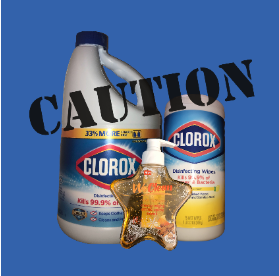Pros and cons of COVID-19 sanitation

Photo credit: Sophia Dragich
According to a study from the University of Saskatchewan, “Too much exposure to hydrogen peroxide could lead to respiratory, skin, and eye irritation.” These health effects can be avoided by using soap and water instead of disinfectants for COVID-19 sanitation.
April 16, 2021
In the era of COVID-19, cleaning and sanitation have become much more intrinsic to our daily lives. Students across the district have been required to sanitize their desks, chairs and desk shields with Clorox wipes before each class period. They are also urged to frequently use hand sanitizer after touching germ-covered surfaces. While these methods seem logical for preventing the spread of a virus, the sudden increase in sanitation products has led me to wonder how the strong chemicals within these products affect the safety of students and staff.
Initially, sanitization products like Clorox wipes and hand sanitizer seem to be perfect for preventing the spread of COVID-19, many of them even advertising that they “Kill 99.9 percent of viruses and bacteria.” However, scientists have proven that disinfectant products can pose alternative health threats.
According to a study from the University of Saskatchewan, increased usage of cleaning products containing hydrogen peroxide (an ingredient found in many cleaning items such as Clorox wipes) can cause skin and eye irritation as well as breathing issues due to a high concentration of chemicals, which pollute the air and therefore negatively impact the people around them. As a result, faculty responsible for the sanitization of the building are more likely to experience these health issues brought about by chemicals, as they use cleaning products regularly.
Knowing the possible health problems that can arise when disinfectants and chemicals are so frequently used, the Center for Disease Control recently updated its guidelines on disinfecting indoor surfaces for COVID-19.
According to a study published on April 6, the CDC recommends using soap and water — not disinfectants — to clean indoor surfaces on regular occasions. If a positive COVID-19 case has been confirmed in the last 24 hours, however, the CDC suggests using disinfectants to clean any surfaces exposed to the virus. If disinfectants are used, schools are advised to allow for proper ventilation, such as opening a window or using a central air system.
This provides new evidence that disinfectants are only necessary in instances when COVID-19 is already present, not on normal occasions. This is not to say that students should stop cleaning their workspaces — the virus is still very infectious. Instead, schools should provide alternative, more environmentally-safe products for cleaning surfaces in classrooms. Unlike disinfectants, these natural substances will properly clean surfaces without harming students or staff in their proximity.
Due to the new evidence gathered by the CDC, the district may eventually choose to cut back on disinfectant use. In the meantime, however, it is advisable that students and staff look out for possible health issues related to disinfectant products while continuing to clean their desks and work spaces regularly.












